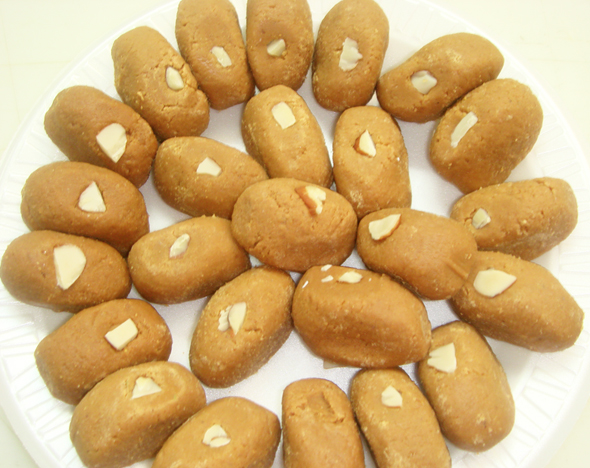Mama’s Punjabi Recipes: Mathura Pede (Sweetened Milk Patties)
Across many parts of North India, many worshippers ask for blessings at mandirs (temples) to give thanks for the old and rejoice for the new and it is customary to offer some sweets to the Gods for their blessings. Outside each mandir, there is at least one shop that sells Indian sweets of the type that are suitable for such offerings: burfi (milk squares), boondi (sweet chickpea drops), laddu (chickpea or flour balls) and pede (sweetened milk patties) are the usual items that they sell.
There are several varieties of pede but the ones that are used for offerings are the small brown ones that have become popular in the holy town of Mathura, the birthplace of Lord Krishna, located in the state of Uttar Pradesh, about 31 miles north of Agra and 90 miles southeast of New Delhi. They Mathura pede are usually small, about 1 inch round, and are so delicious that if you eat one, you’ll eat three more! If you take the Rajdhani Express or other train from Delhi to Bombay, there is a 5 minute stop in Mathura and the hawkers will rush through the train selling boxes of Mathura pede!
Traditionally, pede are made with whole cow’s milk, dry milk and sugar, are very simple to make, and not very time consuming. As a young woman, when we would make them in India, it was customary to use a small chitani weight (one-sixteenth of a kilo piece used for weighing food) to stamp onto the top of the pede for presentation and good luck. You could do the same now using a coin or a bottle cap for the edge design.
The old-fashioned way to make pede is to start with boiling whole cream milk till it becomes khoya (thickened and condensed). This recipe cuts a lot of that time out and is quick and easy to make – in about 30 minutes – and those who eat it will never know the difference.
Ingredients :
325gm cup non-fat milk powder
Medium size whipping cream
1/2 cup bariq chinni (fine sugar)
4 tbsp doodh (milk) – whole or non-fat per your choice
1 tspn chotti illachi (small cardamom) powder
Pinch of kesar (saffron) – to taste
Directions:
1. Pour in the milk in a small saucepan and warm it up over medium heat
2. Add the saffron, mix thoroughly to get a good color and set aside.
3. In a wide kadai (wok) pour in the cream and stir continuously over low heat.
4. Add in the sugar and then add the milk powder and mix thoroughly. Slowly pour in the saffron milk and stir continuously till it is browned and thickened. Be careful that it does not stick to the bottom and burns.
5. Let the mixture cool to the touch. Then take small amounts and knead into a 1 inch ball. Coat your hands with some vegetable oil so that the ball will not stick.
6. Stamp the top of the ball with a bottom cap or any other ornamentation piece and fatten the peda into a thick squat disk.
7. Place on a tray and serve.
MAMA’S TIP OF THE WEEK
WHEN COOKING FROZEN CHAPPATIS, CAREFUL THEY DON’T STICK!
So many people are turning to frozen paranthas and chappatis, at least outside of India, that there are many manufacturers that offer them in the freezer sections of grocery stores. Some of these are pre-cooked, so that all you have to do is take them out and heat them in the oven, over a tava (flatplate) or in the microwave. I have found that generally they taste best if cooked over a tava.
But there are many frozen chappatis that are just flattened out un-cooked dough packed between plastic sheets. If you take them out and leave them while you are cooking them, you’ll find that they quickly thaw out and stick, making it impossible to cook. In this case, use the method that most tandoorwalas use: take the dough out of the plastic sheets and place them on a cloth. This makes it easier to pick them up and place on the tava.
Shakuntla Malhotra is a skilled cook of Punjabi dishes made in the old-fashioned style that she learnt as a young woman in her ancestral home in Lyallpur, India before it became part of Pakistan after the Partition in 1947. People have often admired her cooking for its simplicity and taste that comes with each mouthful. Even in her mid-eighties, she continues to cook daily and agreed to share some of her delectable Punjabi recipes.


